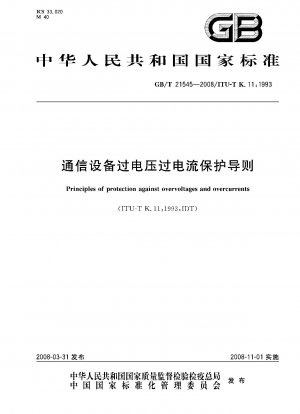GB/T 21545-2008
Principles of protection against overvoltages and overcurrents (English Version)

- Standard No.
- GB/T 21545-2008
- Language
- Chinese, Available in English version
- Release Date
- 2008
- Published By
- General Administration of Quality Supervision, Inspection and Quarantine of the People‘s Republic of China
- Lastest
- GB/T 21545-2008
- Scope
- 1.1 Origin of dangerous overvoltage and overcurrent 1.1.1 Direct lightning strike A direct lightning strike will cause a current of several thousand amps to flow along the wire or cable for several microseconds. Physical damage can occur, and overvoltage surges of thousands of volts can pose a threat to the dielectrics of line equipment and terminal equipment. 1.1.2 The lightning current flowing from cloud to ground or cloud to cloud near the lightning strike will generate overvoltage in the overhead or underground lines near the lightning strike point. In areas with high earth resistivity, the affected area is large. 1.1.3 Induction caused by fault current in power lines (including electrified railways) When a ground fault occurs in the power system, there will be a large unbalanced current flowing along the power line, which will cause induction on nearby telecommunication lines parallel to it. Voltage. The magnitude of this overvoltage can rise to thousands of volts, and its duration is in the range of 200 ms to 1 000 ms (sometimes even longer), depending on the fault removal system used on the power line. 1.1.4 Contact with power lines When power lines and telecommunication lines are damaged by local natural disasters, such as storms and fires, or when normal safety precautions such as isolation and insulation are not adopted, power lines and telecommunication lines may Contact occurs. In areas where the normal power distribution voltage is 220 V (AC RMS), if a fault occurs, it may take a long time to find the fault. In areas where a higher distribution voltage is used, such as 2 kV, if a fault occurs, the protection facilities of the power line can usually guarantee that the voltage will be cut off in a short time. Overvoltage may cause excessive current to flow along the line to the ground point of the switch, causing equipment damage and endangering personal safety. 1.1.5 Elevation of ground potential The ground fault in the power system will generate a current in the soil that will increase the potential near the fault point and the ground electrode of the power supply (see also ITU-T K.9). This ground potential can affect communication equipment in two ways: a) Even if the potential rise of the soil where the ground electrode of the communication signal system is buried relative to the remote ground is less than 5 V, it may cause the signaling system to malfunction. This low voltage can be caused by a glitch in the power system that can persist for a long time without being detected. b) A higher ground potential rise can put workers in the affected area at risk, or in extreme cases, the ground potential rise can be sufficient to break down the insulation of communication cables, causing widespread damage.
GB/T 21545-2008 history
- 2008 GB/T 21545-2008 Principles of protection against overvoltages and overcurrents